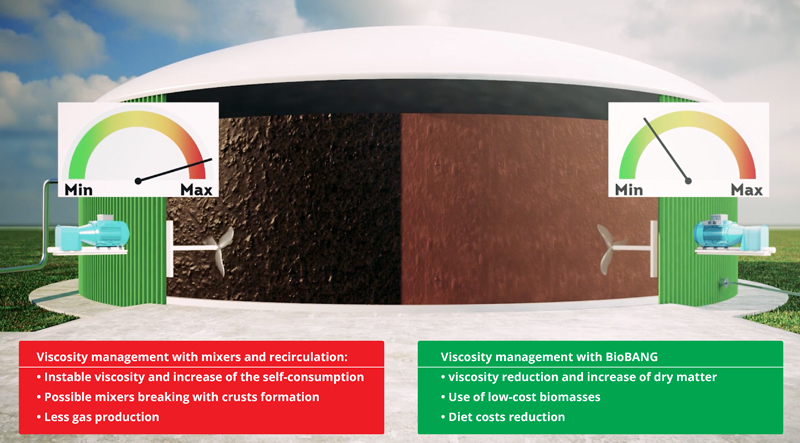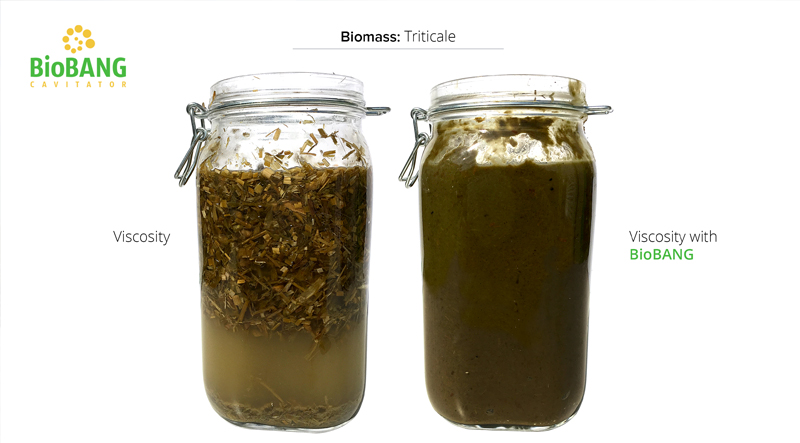BioBANG cavitator is the innovative technology for biogas and biomethane plants, that uses 100% of physic energy in the controlled cavitation. BioBANG ensures the viscosity control in the plant digester, that today is obtained operating on the action on the mixers, on the digestate recirculation and on the solid-liquid relation. BioBANG makes the retention flexible, constant and efficient in the plants.
“When I bought the biogas plant, I hadn’t idea which were the most difficult problems I had to face. I thought there were complex biological reactions, difficult to understand for non-experts, continuous process regulations, mixtures to calibrate, but nobody told me about complications in the digester mix. I didn’t understand how complex was to manage my “stable”, guaranteeing at the same time correct conditions for all bacteria.
At the beginning, I produced biogas using only products very easy to digest, as maize silage, but then I was obliged to use other less expensive materials because of unavailability of this product (last years I lost 30% of harvest because of hail!). And, every time I changed the diet with some more fiber products, something happened at the mixing…
After many attempts in the mixers relocation, that involved manpower and many hours of observation from portholes, I found other height combinations, activation time and orientation, that allowed me to reach a new balance point. For some day all progressed well but, after some time, it returned to original conditions. I saw again outcrops appearing from the evening to the morning and the liquid level in the digester changed, as it swelled. So I started again with mixers relocations, always looking for a new and permanent balance. When mixers couldn’t work again, I tried to add liquid and increased recirculation digestate from final stage to the load.
All this meant an increase in pumping, mix and solid-liquid separation costs, with a consequent reduction of solids retention time and, in the end, in efficiency. I had to use again maize silage and I lost the possibilities that I had using low-cost biomasses (but difficult to homogenize) in the digester.
One day I understood that the problem wasn’t the mix, but the difficulty to keep in suspension a mix of materials compatible with each other. The more I added liquid to facilitate the mix, the more I had to activate the mixers to avoid that fiber materials emerged or settled. So, a triple loss: greater energetic costs, lesser efficiency and lesser possibilities to use more favorable products.

In fact, the mixer allows us to contain the natural tendency of materials to separate, in function of the different density that are typical of them (facilitated from ascending motion of gas that form in the digester bottom), but it doesn’t eradicate the phenomenon.
When I discovered BioBANG, I realized immediately the capability to eliminate in a fixed and definitive way the typical tendency to fiber materials buoyancy. Its action is completed: it breaks tissues, reducing the buoyancy, and minimize the frictions among particles in suspension. In this way, layers of floating material, that create so many problems, don’t develop again. BioBANG action allows at the same time to work with a higher concentration of dry matter.
The viscosity remains stable and low, but with an high capability of liquids suspension, I can use less the mixers and I don’t have to regulate them over and over again. The higher stillness, that derives from these settings, helps the biological processes and, at the same time, the gas emission.

Ultimately, BioBANG totally eliminated my hydraulic problems deriving from continuous diet changes, I could seize all the economic opportunities that derives from availability of more low-cost materials and (why not?) guarding myself against hail. Recommended to all.”
Latest updates
- BioBANG connected to the cogenerator of a biomethane plant
- BioBANG: The unique, innovative and disruptive solution to maximise the efficiency and sustainability of biomethane plants
- Viscosity control: the key to keep the efficiency of your biogas/biomethane plant always high
- Reducing digestate viscosity to optimize the dehydration process in centrifuges
- BioBANG® announces the commissioning of a new unit in France